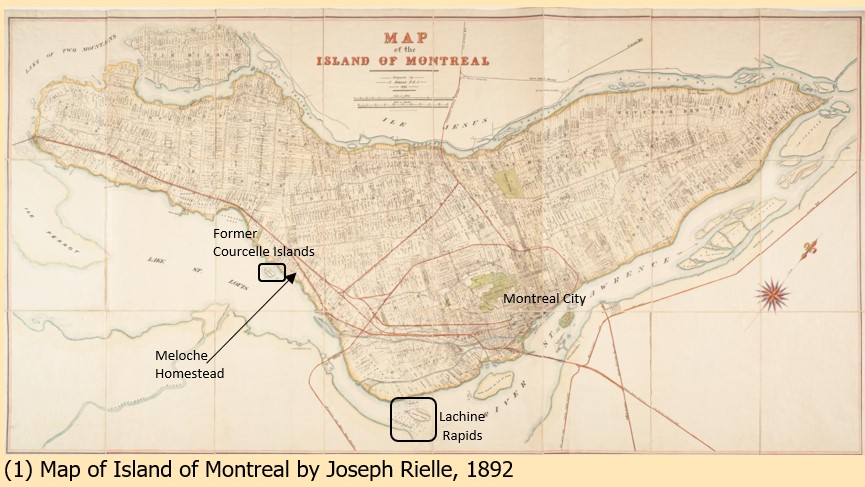
The Meloche homestead was located just to the east of 3 small islands in the St. Lawrence River. During the French Regime these islands were known as the Courcelle Islands, but they were renamed the Dorval Islands in 1691 (see below). They were named after the Governor of Courcelles when he granted them to Sieur Pierre Picoté De Belestre in 1668. In 1685, these islands together with the nearby Fort La Presentation site were re-granted to Agathe Saint-Pierre, future wife of Pierre Le Gardeur de Repentigny. (2)
There is lots of history to recount here. In 1689, the Iroquois used these islands as cover on a misty and stormy daybreak to mount a surprise attack on the sleeping inhabitants of Lachine in the vicinity of the Presentation fort. The attack is famously known as the Lachine massacre of 1689. Let us not forget that this attack was provoked and was in retaliation to a previous attack by the French on the Iroquois. Desirée Girouard (3) prepared a detailed map that tells the story of the attack and its location:
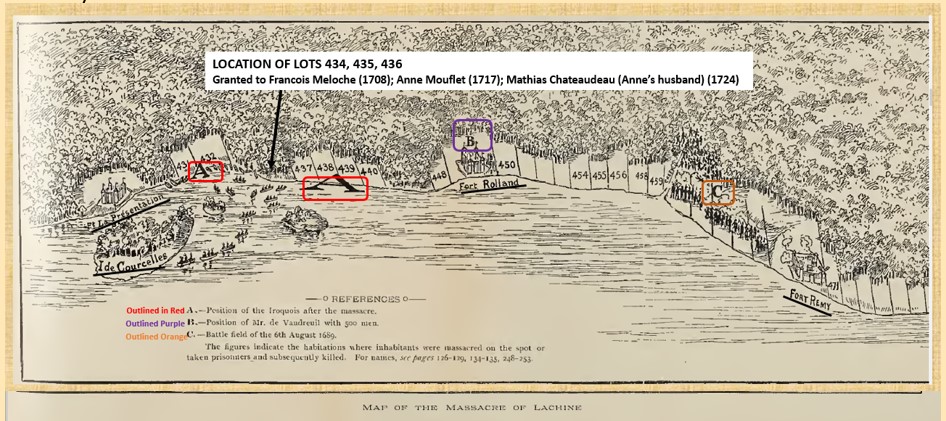
Girouard’s map (see above) includes many details:
-the locations of the Courcelle Islands
-3 of the Forts located at Lachine -from left to right -Fort La Presentation, Fort Rolland and Fort Remy
-the canoe route taken by the Iroquois under cover of the Courcelle Islands
-the Iroquois location after the massacre
-the position of 500 troops under the command of de Vaudreuil at Fort Rolland
-the victims of the massacre are represented by figurines amongst the trees.
In 1691, the site of the Fort La Presentation together with the Courcelle Islands passed into the hands of Jean Bouchard sieur Dorval. He renamed the islands. The largest island was renamed “Dorval”, the smallest island was called Bouchard but became known as “Bushy”. The third island (furthest east) was renamed Dixie.
Here is a Google Satellite image for the islands today with a star indicating the location of the former Meloche homestead:
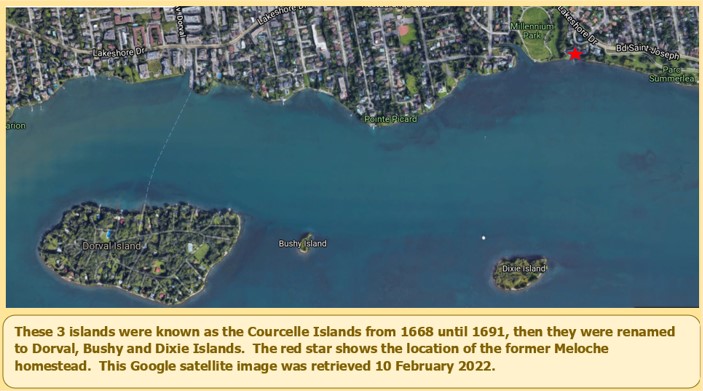
Girouard’s historical map also pinpoints the location of the land concessions granted to the “Famille Meloche”. The land grants were all made many years after the Lachine massacre. By 1708, Francois Meloche and his wife Marie Mouflet had established a homestead, a farm and a fur trading business. Three of their 10 children had already been born.
Francois Meloche passed away in 1741. He is the founding father of a great many Meloche families spread throughout North America, with the largest number in Quebec. It was more than 10 years later, that the successor rights for the family were finalized in the year 1753. During this same year the “Dorval Islands” passed into the hands of Antoine Meloche, the son of Francois. “The islands were used for agricultural purposes, for wood cutting and also as a stopover for fur trade voyageurs going to the Great Lakes. The Meloche family remained owners of the islands until 1854.” (5)
In 1854, Sir George Simpson by then the Governor of the Hudson’s Bay Company purchased the islands and built a luxurious summer home there. Rich and famous people stayed there:
-Prince Albert Edward of Wales
-the famous painter Frances Hopkins
-the photographer William Notman.
Here is a photograph of estate the taken during the late 19th Century. (6)
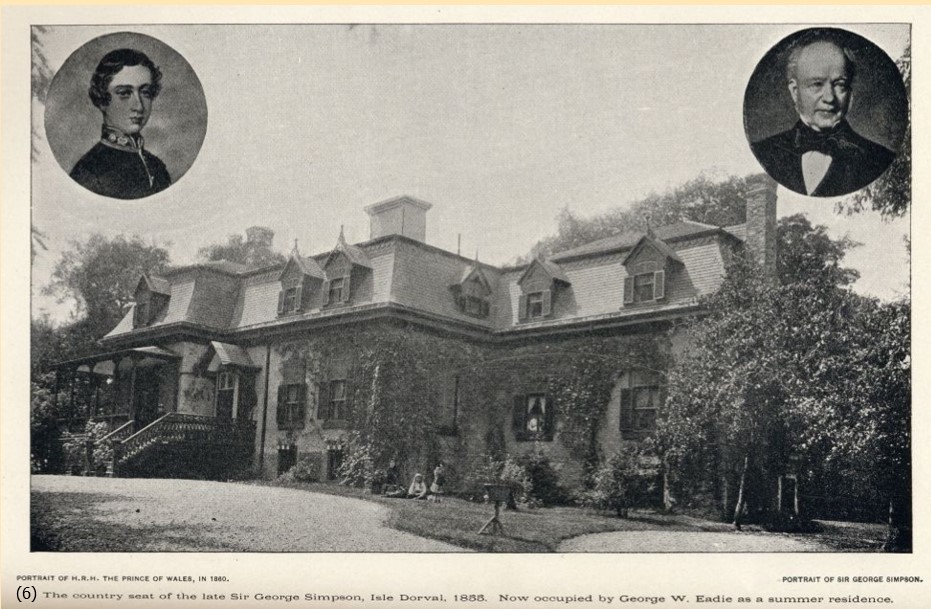
THE MELOCHE LAWSUIT RE THE DORVAL ISLANDS
This landmark legal case is described in detail within Appendix O of the Meloche Legacy. (7) In 1832, then owner of the Dorval islands Jean Baptiste Meloche 1 donated them to his son, Jean Baptiste Meloche 11 on condition that they continue to pass to the male issue as a tradition of succession. In simple terms the land donation from father to son included a clause to preserve the family heritage. The documents were prepared and signed by Notary Jean-Baptiste-Généreux Peltier. The timing was the year before the son was married. The clause ended up being a very big deal.
It seems that there was a change of heart or perhaps once could say a sale opportunity was too good to pass up. So in 1850, both father and son attended the offices of another notary (Hilarion Jobin) and signed a new donation or deed of land, this time the succession clause was omitted.
Then on August 31, 1854, another notary, Joseph Dubreuil prepares another set of documents. This time the documents renounce the heritage succession claim on the three islands.
On September 2, 1854 the same notary prepares a deed of sale for the three islands from Jean Baptiste Meloche 11.
Below is an image of the notary index records, prepared by Joseph Dubreuil on August 31, 1854 and September 2, 1854.(8) Item 590 is the Renunciation of the Successor Rights by Jean Baptiste 1 the father in favor of his son of majority age. Item 591 is the deed of sale from Jean Baptiste 11 to Sir George Simpson.

Sir George Simpson paid $4000 for the three islands. He only enjoyed their use for a few years. Sir George died at Lachine in 1860 and the islands were passed down to his son Pelley and his children. Dorval island was then leased to a number of prominent men until 1911.
In 1893, the Meloche family initiated a lawsuit claiming that the sale of the Dorval Islands to Sir George Simpson was not valid. Brothers Antoine, Alphonse and Jean Baptiste 111, the successor generation, wanted to claim their family heritage! Why had they waited nearly 40 years? What was the trigger that had finally led them to file a lawsuit? James Meloche (7) has proposed a theory about the timing (1893) of the publishing of the book “Lake Saint Louis Old and New….” by Desirée Girouard (6) which mentions the ownership of the Dorval Islands. And most importantly Mr. Girouard had a family connection to the Meloche, he was a lawyer and his family homestead was located nearby. Mr. Girouard, acted as a lawyer for the Meloche brothers until he had to recuse himself during the final appeal as he had been appointed as a judge to the Supreme Court by that time.
The action was dismissed in 1895. The appeal was also dismissed in 1896. But the Meloche brothers persisted. On February 22, 1899 the Supreme Court of Canada ruled in favor of the Meloche brothers and possession of the Dorval Islands was returned to them. It was a landmark decision. It decided once and for all that revoking a succession or “substitution” clause that accompanied a gift or donation was not valid.
Supreme court judge Henri-Elzéar Taschereau held that the Meloche grandparents had no right to revoke the donation of August 15, 1832 to the detriment of their grandsons. The consent of the donee (who was the father of the 3 Meloche brothers) did not change the situation. The judge also decreed that Sir George Simpson had not acted in good faith since he was aware of the 1832 donation.

In 1911, the three Meloche brothers sold Dorval Island to Samuel Carsley Junior, for an undisclosed amount. Within a few years the island was divided into 58 recreational lots, that remain unchanged today:
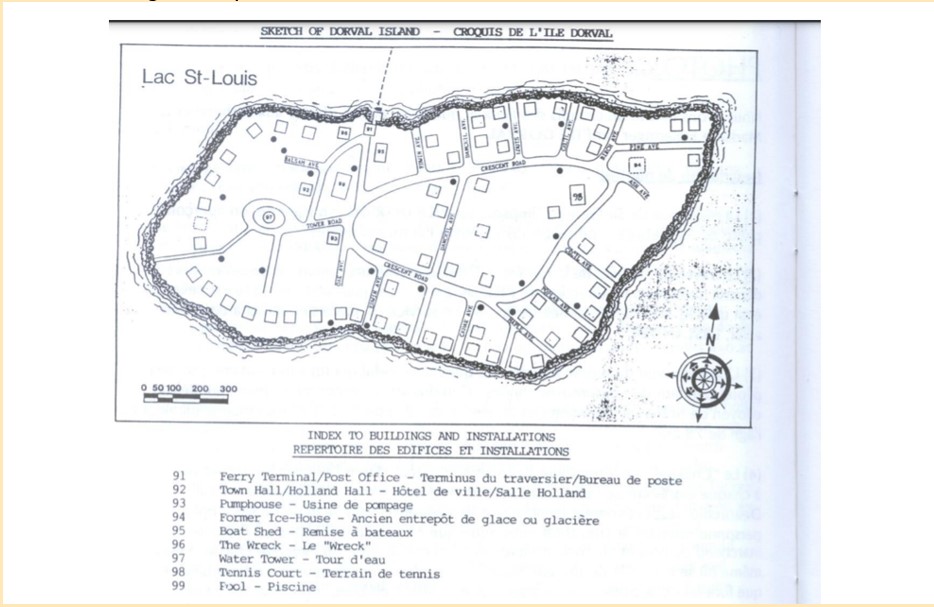
THE DORVAL ISLANDS IN THE 21st CENTURY
There is an eclectic character to the 58 summer residences that are still maintained on the island. (see the pictures below) Access to Dorval Island is by boat only.

As for the two smaller islands, Bushy and Dixie, they are owned by the City of Dorval today.
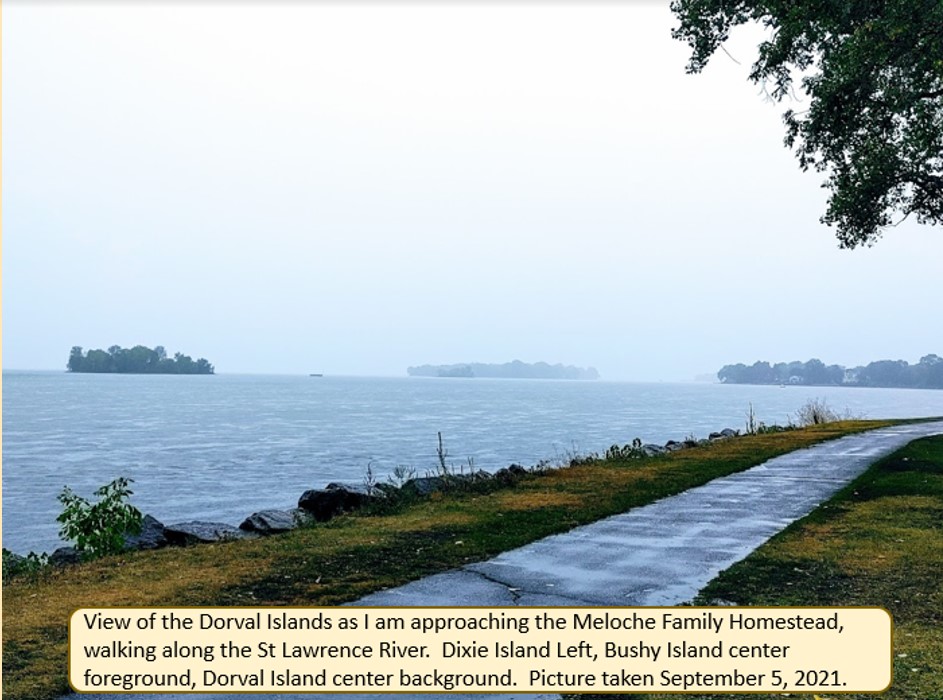
SOURCES
- Joseph Rielle Map of Island of Montreal Accessed 4 January 2022.
- Website: Great repertoire of Montreal’s built heritage [Grand repertoire du Patrimoine bati de Montreal] unsecured website, “Dorval Island” History of Dorval Island Accessed 5 January 2022.
- Map of the Lachine Massacre: Désiré Girouard, Lake Saint Louis Old and New and Cavelier de La Salle (Montreal: Poirier, Bessette and Co, 1893), first image after page 128.
- History of Dorval Island Accessed 5 January 2022.
- See (2)
- Photograph of the George Simpson Estate: Désiré Girouard, Lake Saint Louis Old and New and Cavelier de La Salle (Montreal: Poirier, Bessette and Co, 1893), fourth image after page 240, also available for download Country Seat of the late Sir George Simpson Accessed 5 January 2022.
- James Meloche, The Meloche Legacy: A Family History Dating Back to the Year 1575, (Wisconsin: Association des familles Meloche, 2001), Appendix 0, Item 7.
- BANQ Numerique, Joseph Dubreuil Notary Index Record 591 and 592: Accessed 7 January 2022.
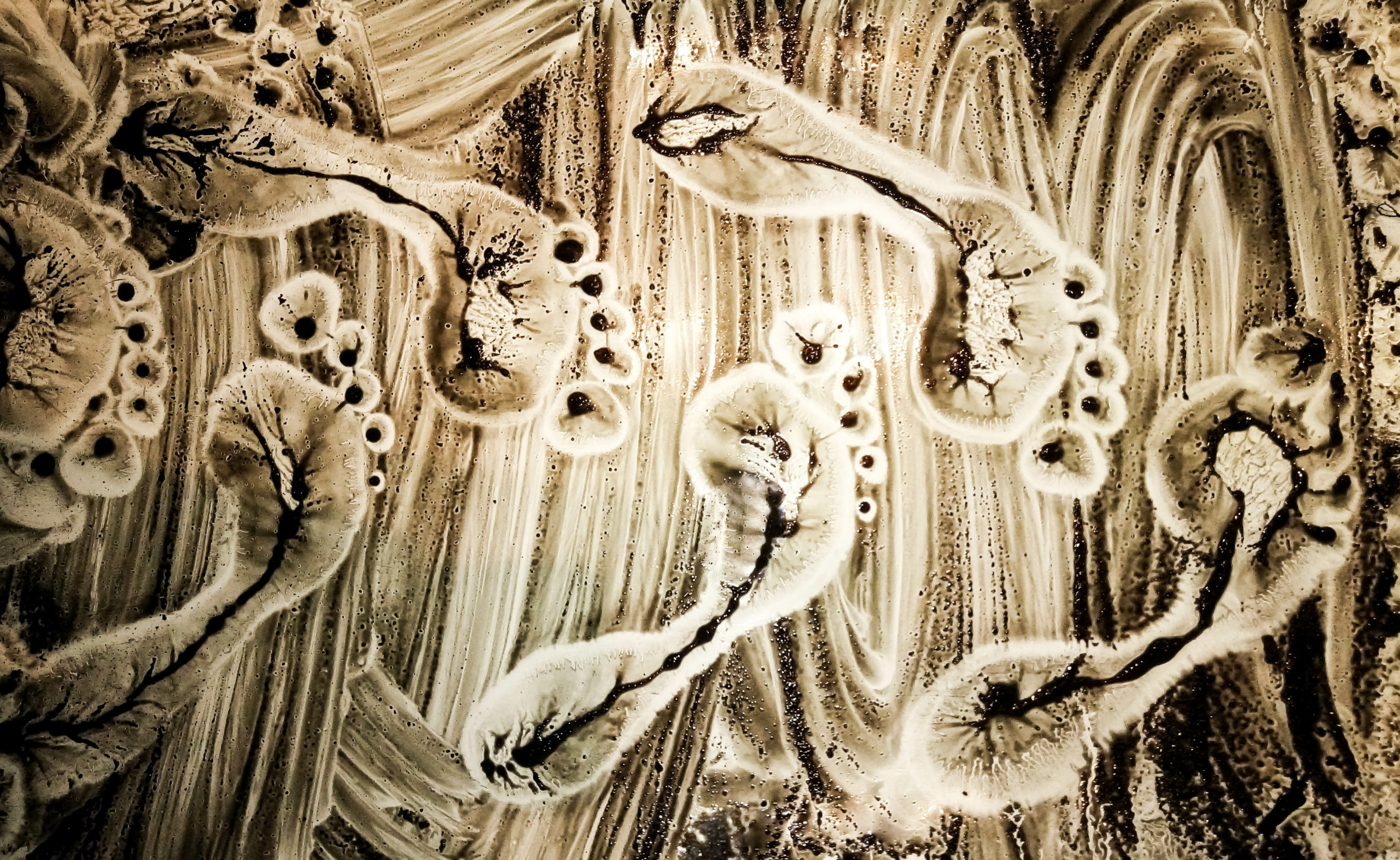
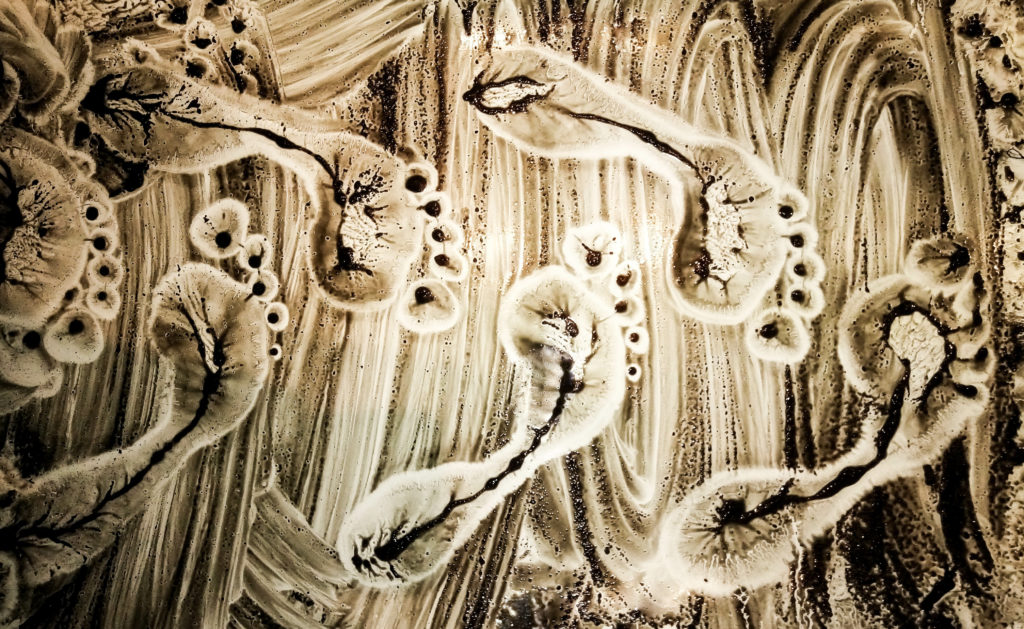

I enjoyed the page about the Meloche family and Dorval island. Did you write this? I am writing a book about my boys growing up in Dorval, having already done one about my own childhood called “A Boomer in Lachine: Growing Up in the 1950s.” Could I make use of this page? It is excellent and most informative!
Thank you for your kind comment about my article “The Unusual Meloche Lawsuit and the Dorval (Courcelle) Island”. Please feel free to use this page for your book, together with an acknowledgement of my blog page as the source.
Everything is very open with a really clear clarification of the issues. It was truly informative. Your site is very helpful. Many thanks for sharing!